Two-Dimensional Topology Optimization of Headtube in Electric Scooter Considering Multiple Loads
Abstract
1. Introduction
2. Design Optimization
2.1. Pixel-Based FE Modeling of Electric Scooter Headtube
2.2. Topology Optimization: Single-Load Conditions
Methodology
2.3. Topology Optimization: Multiple-Load Condition
Methodology
3. Numerical Validation: Comparison of Collision Performance
Methodology
4. Results
4.1. Topology Optimization for Single-Load Conditions
4.2. Topology Optimization for Multiple-Load Conditions
5. Discussion
6. Conclusions
Author Contributions
Funding
Institutional Review Board Statement
Informed Consent Statement
Data Availability Statement
Acknowledgments
Conflicts of Interest
References
- Zagorskas, J.; Burinskiene, M. Challenges Caused by Increased Use of E-Powered Personal Mobility Vehicles in European Cities. Sustainability 2020, 12, 273. [Google Scholar] [CrossRef]
- Kim, Y.W.; Park, W.B.; Cho, J.S.; Hyun, S.Y.; Lee, G. The New Recreational Transportation on the Street: Personal Mobility, Is It Safe? J. Trauma Inj. 2018, 31, 125–134. [Google Scholar] [CrossRef][Green Version]
- Jang, Y.; Ku, D.; Lee, S. Environmental Benefit Calculation on Personal Mobility. Chem. Eng. Trans. 2021, 89, 289–294. [Google Scholar] [CrossRef]
- Oh, J.; Kim, J. Where to Ride? An Explorative Study to Investigate Potential Risk Factors of Personal Mobility Accidents. Int. J. Environ. Res. Public Health 2021, 18, 965. [Google Scholar] [CrossRef]
- Dong, H.B.; Zhang, W. Lightweight Design of Electric Scooter Frame by Finite Element Optimization. Adv. Mater. Res. 2011, 201–203, 49–53. [Google Scholar] [CrossRef]
- Mesicek, J.; Jancar, L.; Ma, Q.-P.; Hajnys, J.; Tanski, T.; Krpec, P.; Pagac, M. Comprehensive View of Topological Optimization Scooter Frame Design and Manufacturing. Symmetry 2021, 13, 1201. [Google Scholar] [CrossRef]
- Chou, J.-R.; Hsiao, S.-W. An Anthropometric Measurement for Developing an Electric Scooter. Int. J. Ind. Ergon. 2005, 35, 1047–1063. [Google Scholar] [CrossRef]
- Hsia, S.Y.; Chou, Y.T. Analysis of Welding Fatigue on Electric Scooter Using CAE Approach. Appl. Mech. Mater. 2013, 291–294, 920–924. [Google Scholar] [CrossRef]
- Shivhare, G.; Kundu, K.; Narayan, J.; Dwivedy, S.K. Design and Modeling of a Compact Lightweight Electric-Scooter. In Proceedings of the 2021 International Conference on Computational Performance Evaluation (ComPE), Shillong, India, 1–3 December 2021; IEEE: Piscataway, NJ, USA, 2021; pp. 944–949. [Google Scholar]
- Yang, R.J.; Chahande, A.I. Automotive Applications of Topology Optimization. Struct. Optim. 1995, 9, 245–249. [Google Scholar] [CrossRef]
- Jang, G.-W.; Yoon, M.-S.; Park, J.H. Lightweight Flatbed Trailer Design by Using Topology and Thickness Optimization. Struct. Multidiscip. Optim. 2010, 41, 295–307. [Google Scholar] [CrossRef]
- Kumagai, M.; Otomori, M.; Ide, T.; Yamada, T.; Izui, K.; Nishiwaki, S. Design Study of Lightweight Automatic Transmission Parts for Vehicles Using Level Set-Based Topology Optimization. In SAE Technical Papers; SAE International: Warrendale, PA, USA, 2016. [Google Scholar]
- Tyflopoulos, E.; Lien, M.; Steinert, M. Optimization of Brake Calipers Using Topology Optimization for Additive Manufacturing. Appl. Sci. 2021, 11, 1437. [Google Scholar] [CrossRef]
- Jang, I.G.; Kim, K.-S.; Kwak, B.M. Conceptual and Basic Designs of the Mobile Harbor Crane Based on Topology and Shape Optimization. Struct. Multidiscip. Optim. 2014, 50, 505–515. [Google Scholar] [CrossRef]
- Jang, I.G.; Kim, I.Y. Computational Study of Wolff’s Law with Trabecular Architecture in the Human Proximal Femur Using Topology Optimization. J. Biomech. 2008, 41, 2353–2361. [Google Scholar] [CrossRef] [PubMed]
- Kim, J.J.; Jang, I.G. Image Resolution Enhancement for Healthy Weight-Bearing Bones Based on Topology Optimization. J. Biomech. 2016, 49, 3035–3040. [Google Scholar] [CrossRef] [PubMed]
- Briot, S.; Goldsztejn, A. Topology Optimization of Industrial Robots: Application to a Five-Bar Mechanism. Mech. Mach. Theory 2018, 120, 30–56. [Google Scholar] [CrossRef]
- Beghini, L.L.; Beghini, A.; Katz, N.; Baker, W.F.; Paulino, G.H. Connecting Architecture and Engineering through Structural Topology Optimization. Eng. Struct. 2014, 59, 716–726. [Google Scholar] [CrossRef]
- Baandrup, M.; Sigmund, O.; Polk, H.; Aage, N. Closing the Gap towards Super-Long Suspension Bridges Using Computational Morphogenesis. Nat. Commun. 2020, 11, 2735. [Google Scholar] [CrossRef]
- Zhu, J.-H.; Zhang, W.-H.; Xia, L. Topology Optimization in Aircraft and Aerospace Structures Design. Arch. Comput. Methods Eng. 2016, 23, 595–622. [Google Scholar] [CrossRef]
- Wang, J.; Zhu, J.; Hou, J.; Wang, C.; Zhang, W. Lightweight Design of a Bolt-Flange Sealing Structure Based on Topology Optimization. Struct. Multidiscip. Optim. 2020, 62, 3413–3428. [Google Scholar] [CrossRef]
- Yu, Y.; Jang, I.G.; Kwak, B.M. Topology Optimization for a Frequency Response and Its Application to a Violin Bridge. Struct. Multidiscip. Optim. 2013, 48, 627–636. [Google Scholar] [CrossRef]
- Tian, Y.; Liu, X.; Xu, Q.; Luo, Q.; Zheng, H.; Song, C.; Zhu, Z.; Gao, K.; Dang, C.; Wang, H.; et al. Bionic Topology Optimization of Fins for Rapid Latent Heat Thermal Energy Storage. Appl. Therm. Eng. 2021, 194, 117104. [Google Scholar] [CrossRef]
- Chen, Y.; Meng, F.; Huang, X. Creating Acoustic Topological Insulators through Topology Optimization. Mech. Syst. Signal Process. 2021, 146, 107054. [Google Scholar] [CrossRef]
- Rezaei, S.; Kadkhodapour, J.; Hamzehei, R.; Taherkhani, B.; Anaraki, A.P.; Dariushi, S. Design and Modeling of the 2D Auxetic Metamaterials with Hyperelastic Properties Using Topology Optimization Approach. Photonics Nanostructures—Fundam. Appl. 2021, 43, 100868. [Google Scholar] [CrossRef]
- Chen, X.; Yang, L.; Gong, Y.; Liu, K. Lightweight design of multi-material body structure based on material selection method and implicit parametric modeling. Proc. Inst. Mech. Eng. Part D J. Automob. Eng. 2024, 16, 22–34. [Google Scholar] [CrossRef]
- Sun, J.; Hu, H. Dynamic Topology Optimization of Flexible Multibody Systems. Nonlinear Dyn. 2024, 112, 11711–11743. [Google Scholar] [CrossRef]
- Yao, P.; Zhou, K.; Lin, Y.; Tang, Y. Light-Weight Topological Optimization for Upper Arm of an Industrial Welding Robot. Metals 2019, 9, 1020. [Google Scholar] [CrossRef]
- Nozawa, S.; Serhat, G. Topology and Fiber Path Optimization of Composite Structures: A Critical Review. Mater. Des. 2025, 251, 113699. [Google Scholar] [CrossRef]
- Huang, D.; Zhou, S.; Yan, X. Multi-objective topology optimization design of thermal-mechanical coupling structure based on FPTO method. Optim. Eng. 2024, 26, 53–81. [Google Scholar] [CrossRef]
- Kim, M.G.; Kim, J.S.; Kim, J.J. 2-D Topology Optimization of the Connection Part of the Electric Kickboard in Case of Front Collision. J. Korean Soc. Precis. Eng. 2022, 39, 841–848. [Google Scholar] [CrossRef]
- Verhulp, E.; van Rietbergen, B.; Huiskes, R. Comparison of Micro-Level and Continuum-Level Voxel Models of the Proximal Femur. J. Biomech. 2006, 39, 2951–2957. [Google Scholar] [CrossRef]
- Van Rietbergen, B.; Huiskes, R.; Eckstein, F.; Rüegsegger, P. Trabecular Bone Tissue Strains in the Healthy and Osteoporotic Human Femur. J. Bone Miner. Res. 2003, 18, 1781–1788. [Google Scholar] [CrossRef] [PubMed]
- Van Rietbergen, B.; Müller, R.; Ulrich, D.; Rüegsegger, P.; Huiskes, R. Tissue Stresses and Strain in Trabeculae of a Canine Proximal Femur Can Be Quantified from Computer Reconstructions. J. Biomech. 1999, 32, 165–173. [Google Scholar] [CrossRef] [PubMed]
- Bendsøe, M.P. Optimal Shape Design as a Material Distribution Problem. Struct. Optim. 1989, 1, 193–202. [Google Scholar] [CrossRef]
- Rozvany, G.I.N.; Zhou, M.; Birker, T. Generalized Shape Optimization without Homogenization. Struct. Optim. 1992, 4, 250–252. [Google Scholar] [CrossRef]
- Sigmund, O. A 99 Line Topology Optimization Code Written in Matlab. Struct. Multidiscip. Optim. 2001, 21, 120–127. [Google Scholar] [CrossRef]
- Sigmund, O. Design of Material Structures Using Topology Optimization. Doctoral Dissertation, Technical University of Denmark, Kongens Lyngby, Denmark, 1994. [Google Scholar]
- Sigmund, O. On the Design of Compliant Mechanisms Using Topology Optimization. Mech. Struct. Mach. 1997, 25, 493–524. [Google Scholar] [CrossRef]
- Bendsøe, M.P. Optimization of Structural Topology, Shape, and Material; Springer: Berlin/Heidelberg, Germany, 1995; ISBN 978-3-662-03117-9. [Google Scholar]
- Prima, S.; Ourselin, S.; Ayache, N. Computation of the Mid-Sagittal Plane in 3-D Brain Images. IEEE Trans. Med. Imaging 2002, 21, 122–138. [Google Scholar] [CrossRef]
- Yoon, C.H.; Kim, H.S.; Ju, J.H.; Jee, W.H.; Park, S.H.; Kim, H.Y. Validity of the Sonographic Longitudinal Sagittal Image for Assessment of the Cartilage Thickness in the Knee Osteoarthritis. Clin. Rheumatol. 2008, 27, 1507–1516. [Google Scholar] [CrossRef]
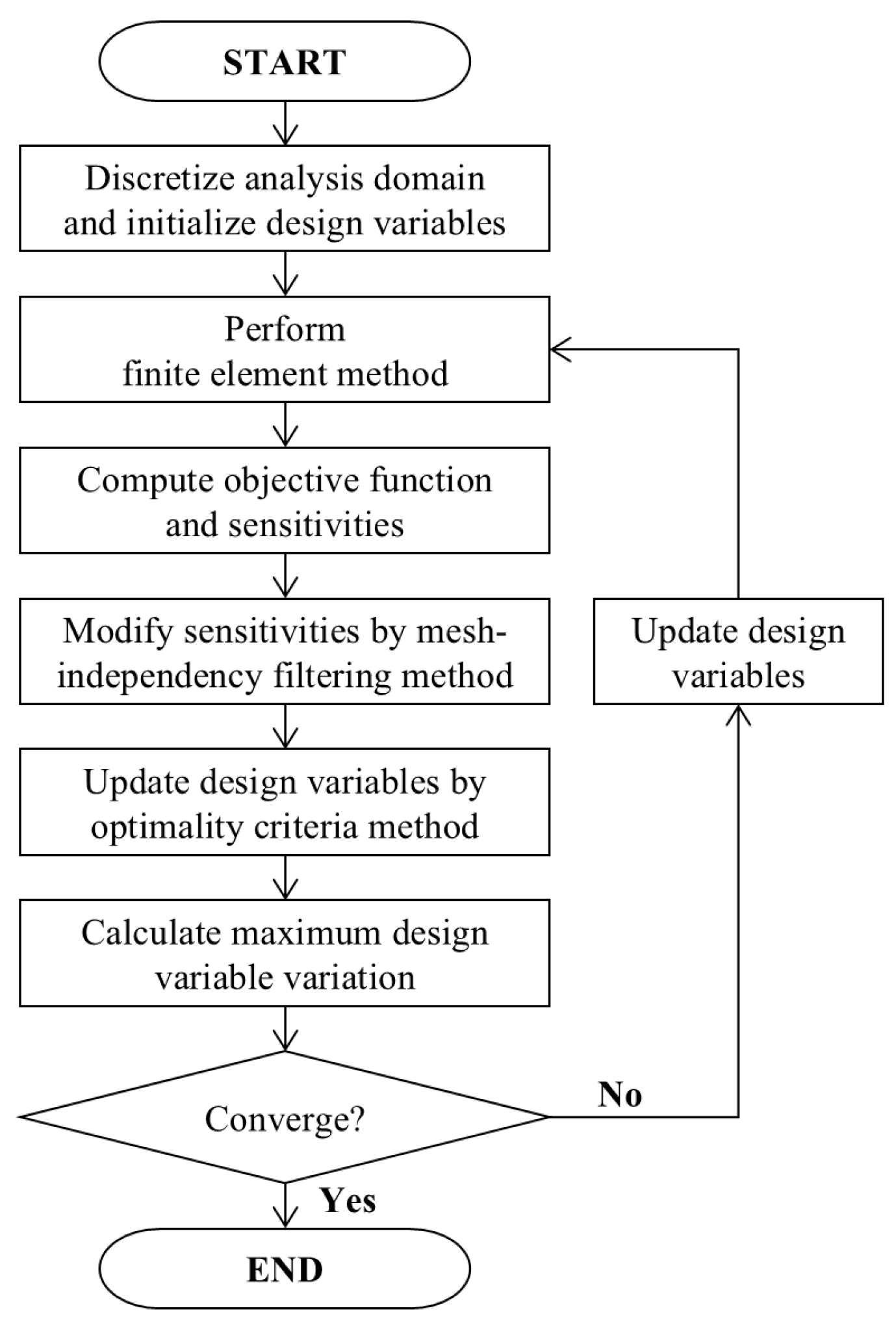
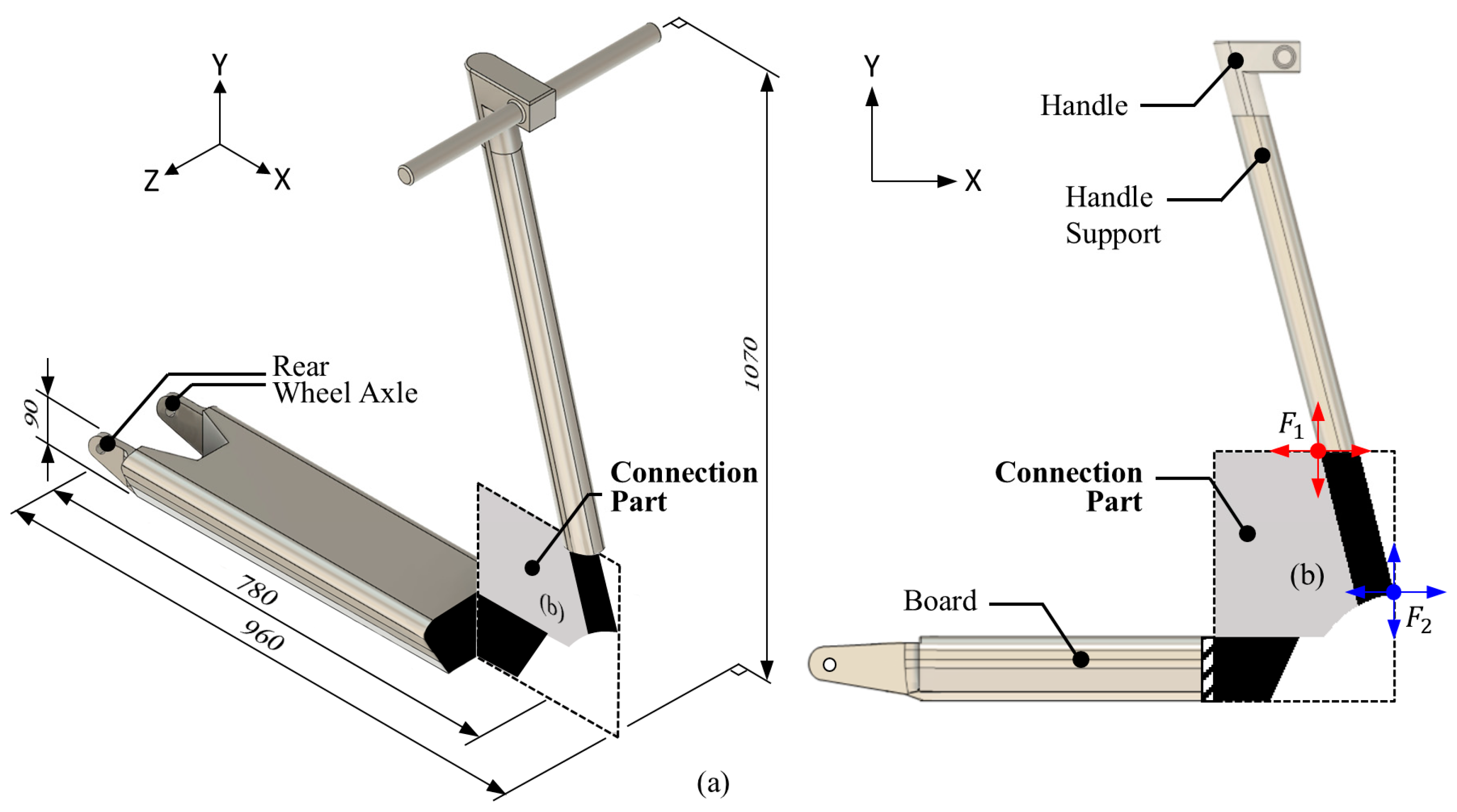


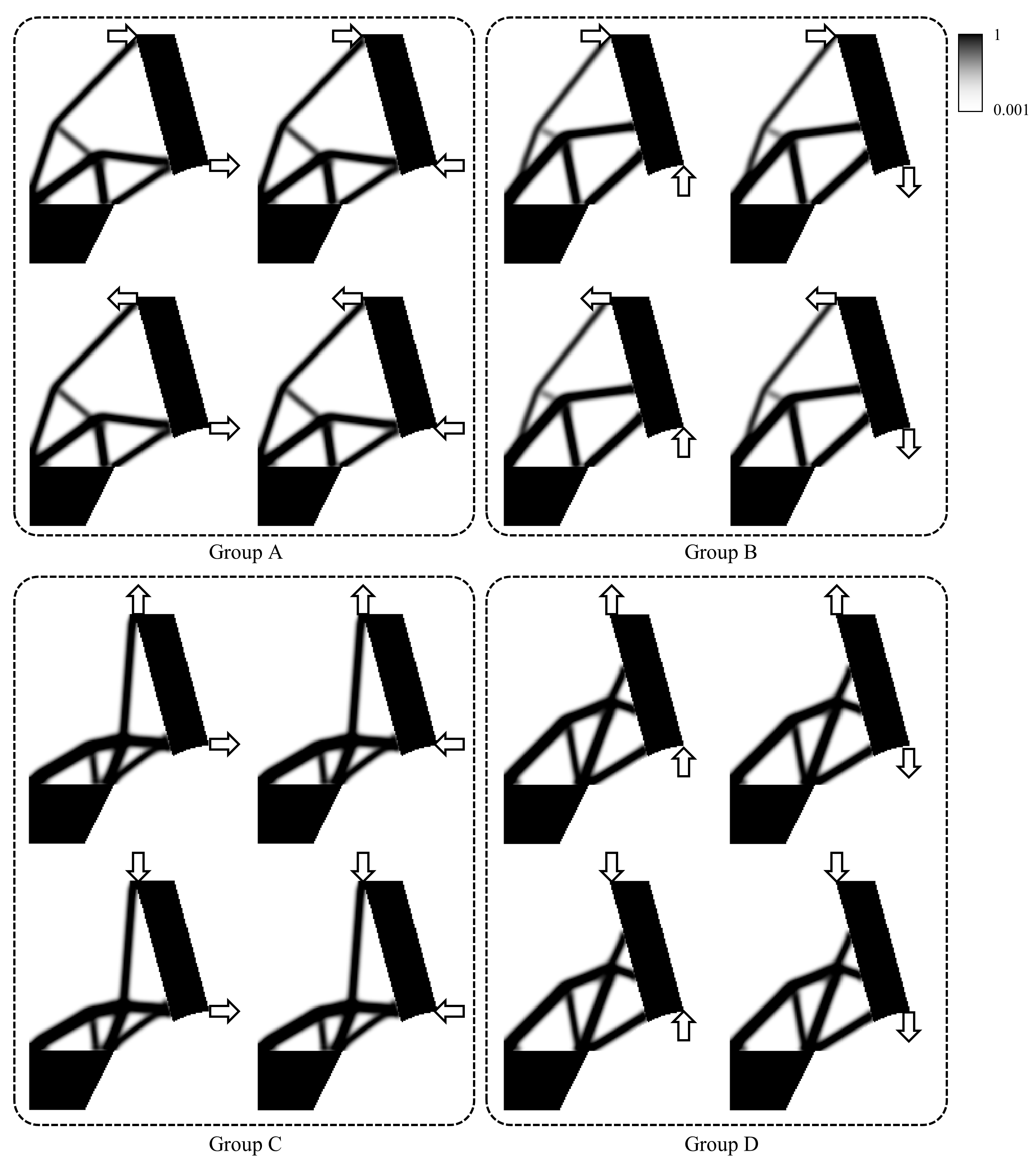
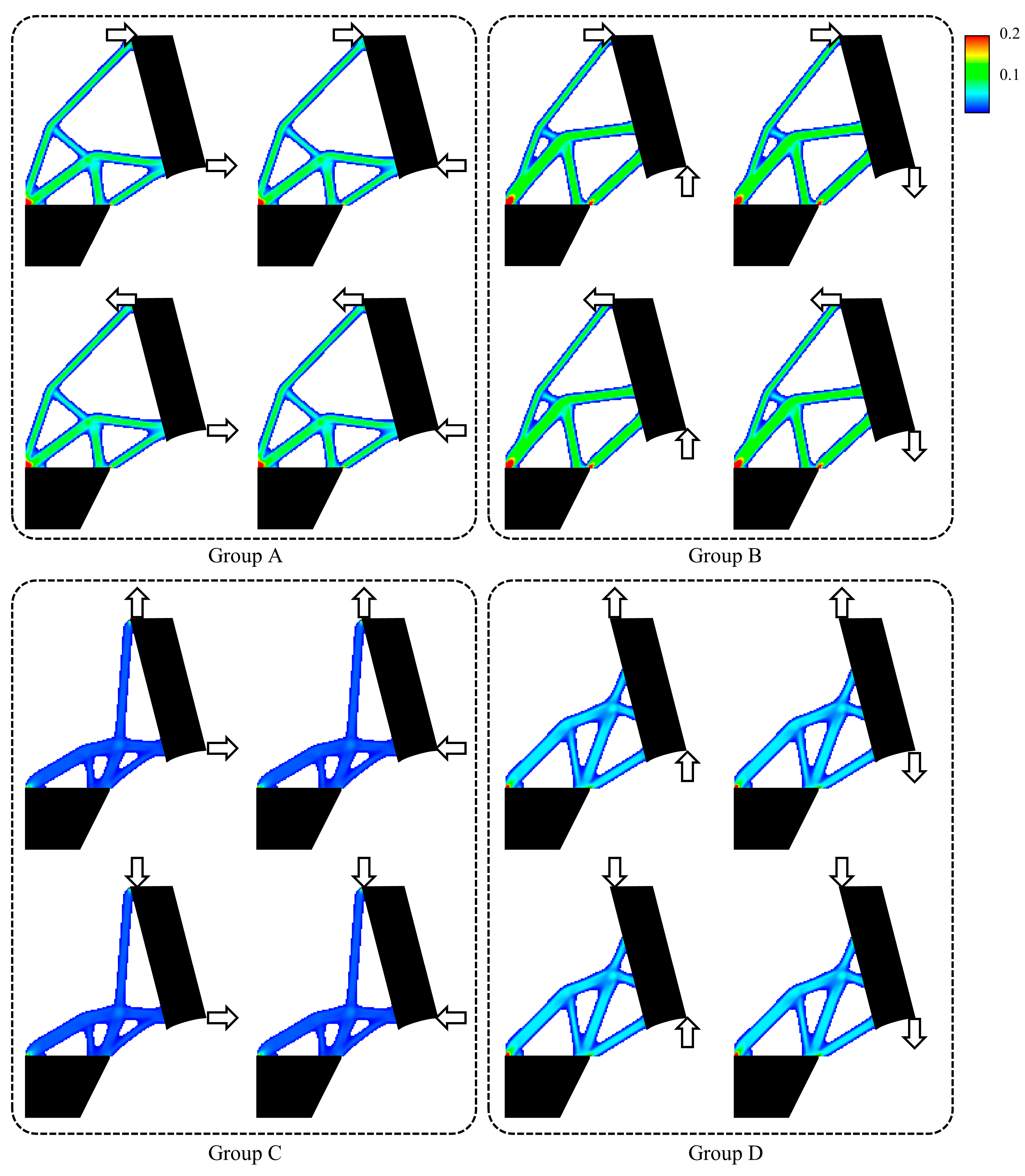
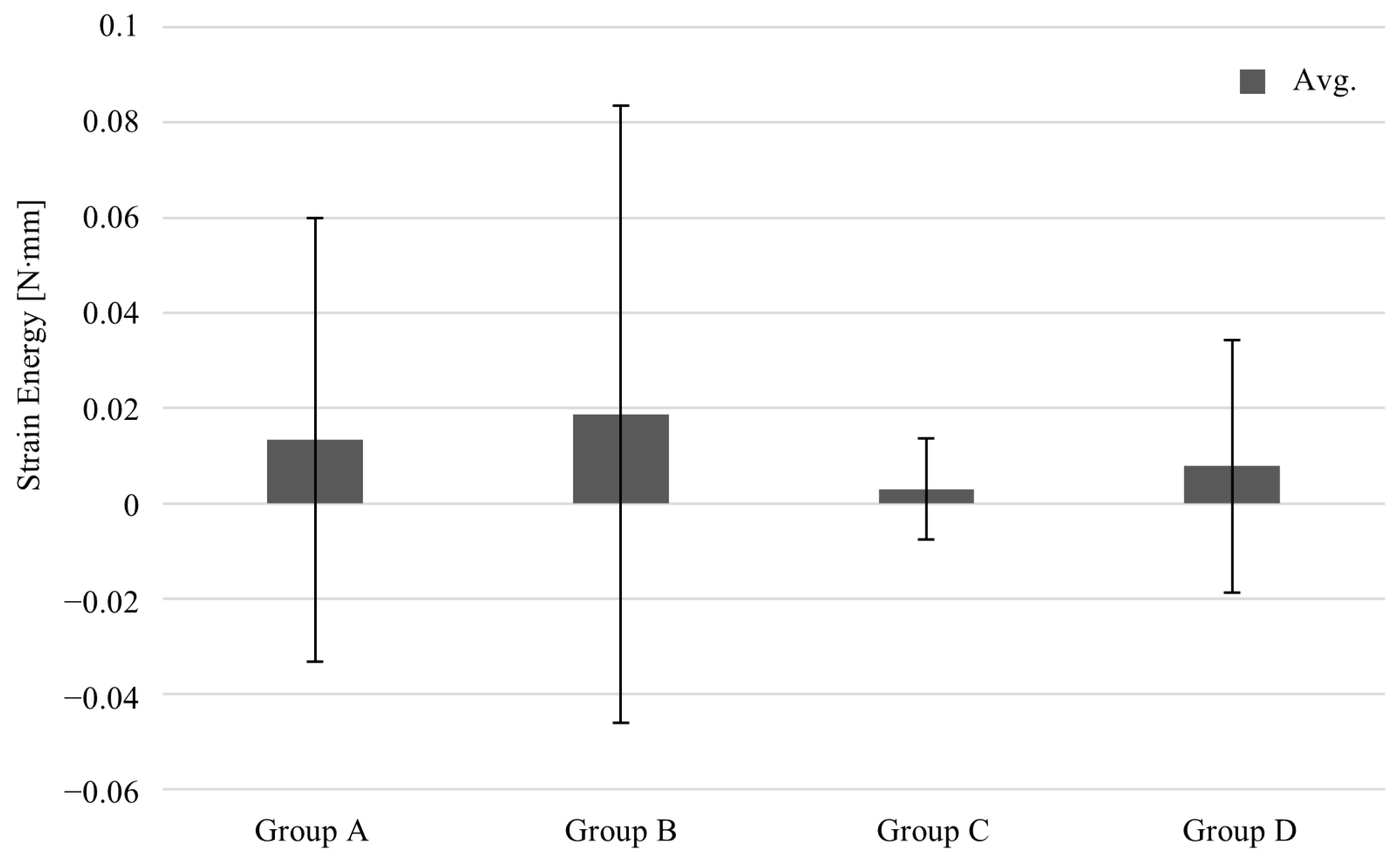
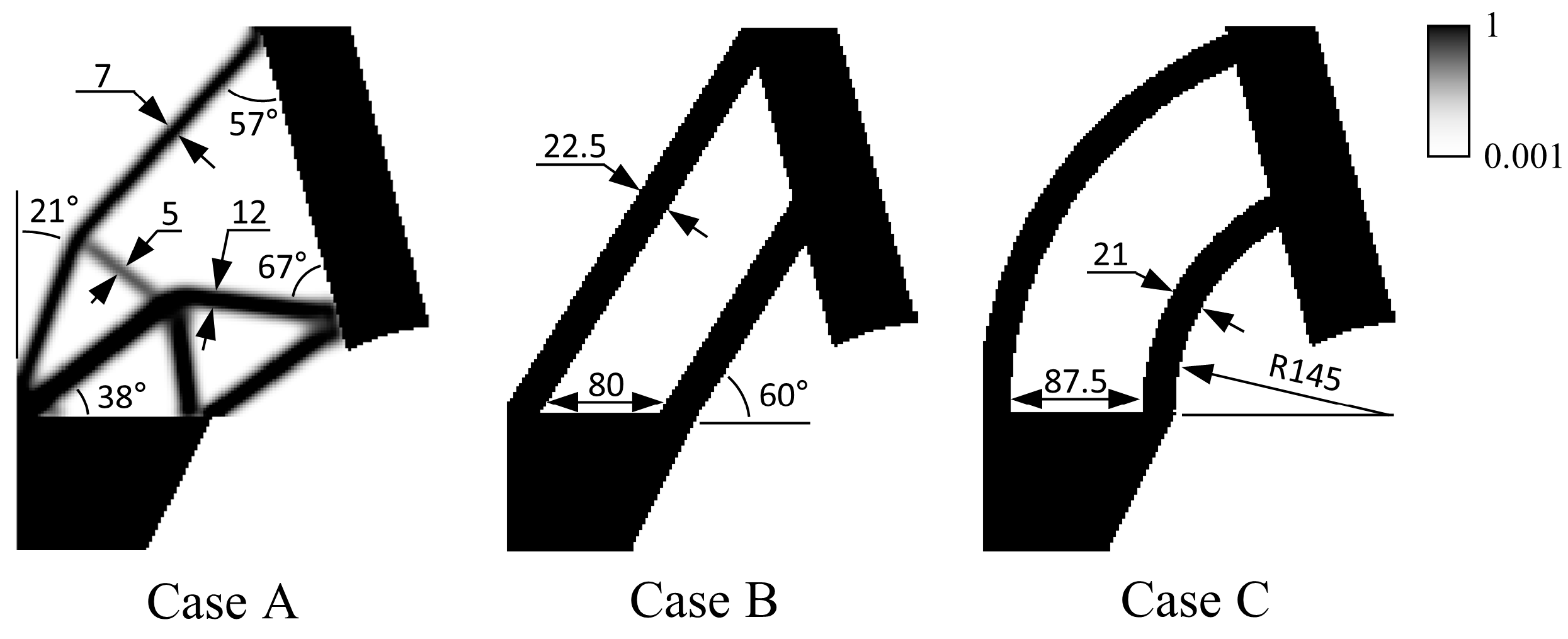
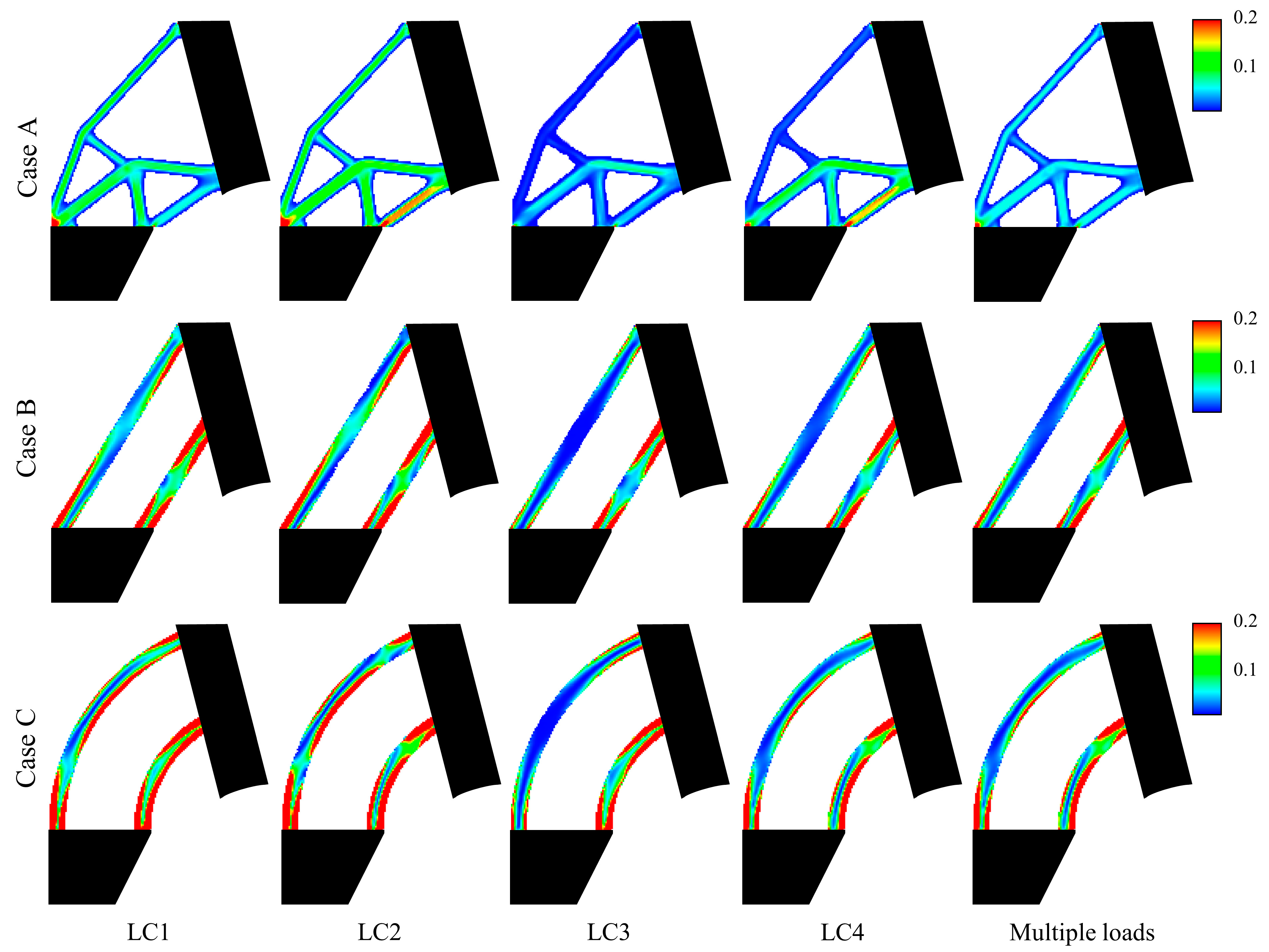

| Group | Group A | Group B | Group C | Group D | |
|---|---|---|---|---|---|
| 164.39108 | 231.94289 | 36.76632 | 96.38500 | ||
| Max. | 3.77893 | 5.22481 | 0.71936 | 2.16243 | |
| Avg. | 0.01329 | 0.01875 | 0.00297 | 0.00779 | |
| Std. | 0.04656 | 0.06474 | 0.01060 | 0.02661 | |
| Iteration | 56 | 431 | 248 | 123 | |
| Loading Condition (LC) | Model (Case) | Compliance | |||
|---|---|---|---|---|---|
| Max. | Avg. | Std. | |||
| LC 1 | A | 167.5879 | 3.9634 | 0.0135 | 0.0485 |
| B | 484.8086 | 3.9177 | 0.0392 | 0.1696 | |
| C | 891.5683 | 14.6701 | 0.0721 | 0.3375 | |
| LC 2 | A | 241.9688 | 5.3093 | 0.0196 | 0.0673 |
| B | 427.5641 | 3.6456 | 0.0346 | 0.1374 | |
| C | 858.5088 | 20.5374 | 0.0694 | 0.3546 | |
| LC 3 | A | 63.8170 | 0.6226 | 0.0052 | 0.0155 |
| B | 282.5795 | 2.8343 | 0.0280 | 0.1154 | |
| C | 447.6028 | 8.5388 | 0.0362 | 0.1990 | |
| LC 4 | A | 138.1978 | 1.9685 | 0.0112 | 0.0367 |
| B | 225.3350 | 1.7904 | 0.0182 | 0.0752 | |
| C | 414.5432 | 7.4465 | 0.0335 | 0.1596 | |
| Multiple Loads | A | 105.0518 | 2.3131 | 0.0085 | 0.0290 |
| B | 298.7380 | 2.2340 | 0.0241 | 0.1022 | |
| C | 549.4200 | 9.1967 | 0.0444 | 0.2050 | |
Disclaimer/Publisher’s Note: The statements, opinions and data contained in all publications are solely those of the individual author(s) and contributor(s) and not of MDPI and/or the editor(s). MDPI and/or the editor(s) disclaim responsibility for any injury to people or property resulting from any ideas, methods, instructions or products referred to in the content. |
© 2025 by the authors. Licensee MDPI, Basel, Switzerland. This article is an open access article distributed under the terms and conditions of the Creative Commons Attribution (CC BY) license (https://creativecommons.org/licenses/by/4.0/).
Share and Cite
Kim, M.G.; Choi, J.W.; Kim, J.J. Two-Dimensional Topology Optimization of Headtube in Electric Scooter Considering Multiple Loads. Appl. Sci. 2025, 15, 2829. https://doi.org/10.3390/app15052829
Kim MG, Choi JW, Kim JJ. Two-Dimensional Topology Optimization of Headtube in Electric Scooter Considering Multiple Loads. Applied Sciences. 2025; 15(5):2829. https://doi.org/10.3390/app15052829
Chicago/Turabian StyleKim, Min Gyu, Jun Won Choi, and Jung Jin Kim. 2025. "Two-Dimensional Topology Optimization of Headtube in Electric Scooter Considering Multiple Loads" Applied Sciences 15, no. 5: 2829. https://doi.org/10.3390/app15052829
APA StyleKim, M. G., Choi, J. W., & Kim, J. J. (2025). Two-Dimensional Topology Optimization of Headtube in Electric Scooter Considering Multiple Loads. Applied Sciences, 15(5), 2829. https://doi.org/10.3390/app15052829






